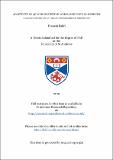Files in this item
Adaptivity of 3D web content in web-based virtual museums : a quality of service and quality of experience perspective
Item metadata
| dc.contributor.advisor | Quigley, Aaron John | |
| dc.contributor.advisor | Nacenta, Miguel | |
| dc.contributor.author | Bakri, Hussein | |
| dc.coverage.spatial | xvii, 332 p. | en_US |
| dc.date.accessioned | 2019-09-11T09:12:26Z | |
| dc.date.available | 2019-09-11T09:12:26Z | |
| dc.date.issued | 2019-12-03 | |
| dc.identifier.uri | https://hdl.handle.net/10023/18453 | |
| dc.description.abstract | The 3D Web emerged as an agglomeration of technologies that brought the third dimension to the World Wide Web. Its forms spanned from being systems with limited 3D capabilities to complete and complex Web-Based Virtual Worlds. The advent of the 3D Web provided great opportunities to museums by giving them an innovative medium to disseminate collections' information and associated interpretations in the form of digital artefacts, and virtual reconstructions thus leading to a new revolutionary way in cultural heritage curation, preservation and dissemination thereby reaching a wider audience. This audience consumes 3D Web material on a myriad of devices (mobile devices, tablets and personal computers) and network regimes (WiFi, 4G, 3G, etc.). Choreographing and presenting 3D Web components across all these heterogeneous platforms and network regimes present a significant challenge yet to overcome. The challenge is to achieve a good user Quality of Experience (QoE) across all these platforms. This means that different levels of fidelity of media may be appropriate. Therefore, servers hosting those media types need to adapt to the capabilities of a wide range of networks and devices. To achieve this, the research contributes the design and implementation of Hannibal, an adaptive QoS & QoE-aware engine that allows Web-Based Virtual Museums to deliver the best possible user experience across those platforms. In order to ensure effective adaptivity of 3D content, this research furthers the understanding of the 3D web in terms of Quality of Service (QoS) through empirical investigations studying how 3D Web components perform and what are their bottlenecks and in terms of QoE studying the subjective perception of fidelity of 3D Digital Heritage artefacts. Results of these experiments lead to the design and implementation of Hannibal. | en_US |
| dc.language.iso | en | en_US |
| dc.publisher | University of St Andrews | |
| dc.subject | Adaptivity | en_US |
| dc.subject | 3D Web | en_US |
| dc.subject | Web-based virtual museum | en_US |
| dc.subject | Web-based virtual world | en_US |
| dc.subject | QoS | en_US |
| dc.subject | QoE | en_US |
| dc.subject.lcc | AM7.B2 | |
| dc.subject.lcsh | Cultural property--Computer simulation | en |
| dc.subject.lcsh | Three-dimensional imaging | en |
| dc.subject.lcsh | Museums--Information technology | en |
| dc.subject.lcsh | Museum techniques | en |
| dc.title | Adaptivity of 3D web content in web-based virtual museums : a quality of service and quality of experience perspective | en_US |
| dc.type | Thesis | en_US |
| dc.contributor.sponsor | University of St Andrews. St Leonard's College Scholarship | en_US |
| dc.contributor.sponsor | University of St Andrews. School of Computer Science | en_US |
| dc.type.qualificationlevel | Doctoral | en_US |
| dc.type.qualificationname | PhD Doctor of Philosophy | en_US |
| dc.publisher.institution | The University of St Andrews | en_US |
| dc.publisher.department | School of Computer Science | en_US |
| dc.identifier.doi | https://doi.org/10.17630/10023-18453 |
This item appears in the following Collection(s)
Items in the St Andrews Research Repository are protected by copyright, with all rights reserved, unless otherwise indicated.

